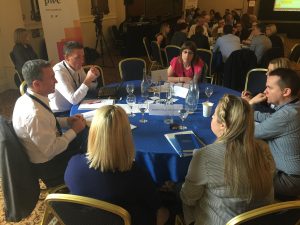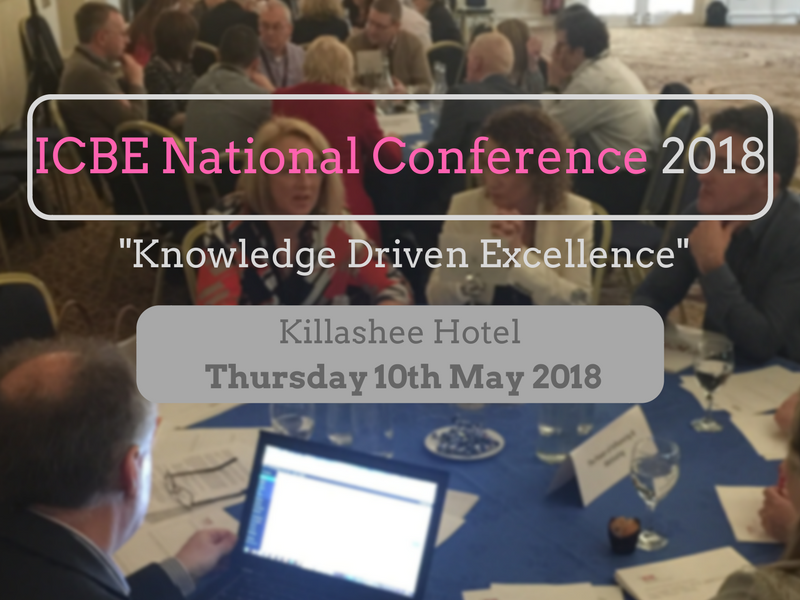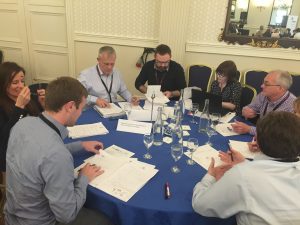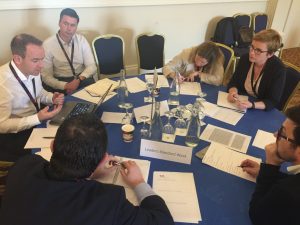 The discussion around Leaders Standard Work’ resulted in very easy and natural conversation, each person engaged on the topic with positive body language. Individuals had experience of LSW and shared their experiences of its implementation with the over all group.
The discussion around Leaders Standard Work’ resulted in very easy and natural conversation, each person engaged on the topic with positive body language. Individuals had experience of LSW and shared their experiences of its implementation with the over all group.
The second group were as engaged and very positive on the process of collecting feedback. A bit apprehensive initially but found it very good.
In discussing ‘Leaders Standard Work’ the individual impacts were:
- A tool for sustaining work not for making the change. Do-It after improvements are implemented
- Shows a strong level of respect to front line staff, leaders work for the staff. Grows credibility
- Provides a framework to do take on new roles (eg become a coach or take on a leadership role) allows leaders who are technical and not ops experts us this to have a methodology to drive Ops. Provides continuity, consistence and standardizing work that is done on daily basis.
- For companies not using it can be used as new tool to measure what site management are doing and how could we use LSW (eg help with efficiency of meetings and drive improvements)
- Provides an opportunity to be aware of lightbulb moments from staffs. Leaders getting the voice of the team, forces leaders to listen to the team
- LSW can be as prescribed as necessary eg recognition walk does not state exactly what should be asked, they leaders have guidelines however they can go deeper to document exact details
- Provides an opp to get Lightbulb moments from staffs. Leaders getting the voice of the team, listening to the team.
- Requires peer accountability to keep leaders.
- Getting started do a phased approached, implement 1 item and enhance Implementing all of this quickly will frighten staff
- Behaviors of the leader is critical , should be engaging, involved, asking as opposed to telling.
- Who benefits form this LSW? Are the staff getting something out of it? Need staff to evaluate that it is working and have that checkmark in place. Great tool to sustain, do not make it a tick the box exercise
- Leaders should be accountable for action. Close the loop and feedback. Setting expectations on leaders. If people believe in it and if something breaks down (eg no meeting) who cares about it and who will flag this as an issue
- People need to see value – needs to be 2 way communication and leaders know what is expected of them. Engagement.
- Part of an eco system of LSW in tandem with Lean tools. “People respect what you inspect” Fundamental to sustain the change

 Following a discussion of ‘The power of influencing and Motivating’ the group felt that the impact on the organisation was: mutually beneficial, thought provoking, inspired some small simple changes and awareness of your own presence. Other points included
Following a discussion of ‘The power of influencing and Motivating’ the group felt that the impact on the organisation was: mutually beneficial, thought provoking, inspired some small simple changes and awareness of your own presence. Other points included All agreed ‘Employing Continuous Improvement as a Means to Engage the Disengaged’ was very relevant – continuous improvement is completely dependent on engagement. Other observations included:
All agreed ‘Employing Continuous Improvement as a Means to Engage the Disengaged’ was very relevant – continuous improvement is completely dependent on engagement. Other observations included: Following a discussion of ‘The(r)Evolution of Performance Management to unleash Organisation & Individual Potential’ the group shared the following
Following a discussion of ‘The(r)Evolution of Performance Management to unleash Organisation & Individual Potential’ the group shared the following There was some level of ‘Leaders Standard Work’ in place in some of the organisations and a general understanding of the concept around the table.
There was some level of ‘Leaders Standard Work’ in place in some of the organisations and a general understanding of the concept around the table.